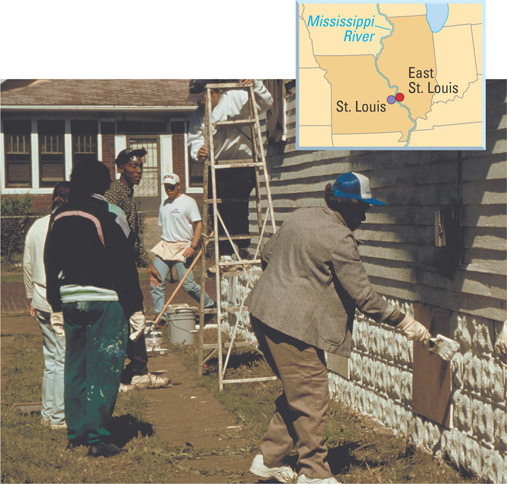Section 4 Providing a Safety Net
Preview
Objectives
After studying this section you will be able to:
- Summarize the U.S. political debate on ways to fight poverty.
- Describe the main programs through which the government redistributes income.
Section Focus
Sometimes the United States government has to step in to create programs to aid poor, disabled, and elderly people.
Key Terms
- poverty threshold
- welfare
- cash transfers
- in-kind benefits
Prosperity is a hazy memory in East St. Louis. Tumble-down buildings and weed-covered lots scar the urban landscape. Poverty and unemployment are constant companions in this Illinois city of 40,000 or so residents.
The city hugs the banks of the Mississippi River across from its prosperous big brother, St. Louis, Missouri, a city of more than 330,000 people. At one time, both cities profited from their locations on the busy river. But in the 1970s the firms of East St. Louis packed up and fled, having found better business opportunities elsewhere. With few businesses to tax and a jobless population, the city edged toward bankruptcy, unable to provide even the most basic services, like garbage collection and police and fire protection. At the end of the twentieth century, while much of the United States enjoyed economic growth, East St. Louis struggled merely to exist.
The Poverty Problem
While the free market has proven better at generating wealth than has any other economic system, that wealth is spread unevenly throughout society. This leaves some people below the poverty threshold, an income level below that which is needed to support families or households. The poverty threshold is a relative figure determined by the federal government and adjusted periodically. In 2004, the poverty threshold for a single parent under age 65, with one child, was $12,490. For a four-person family with two children, it was $18,850. In East St. Louis, 42 percent of families with children live below the poverty line. The median household income is about $25,000 a year.
The Government's Role
The opportunities that the free market offers can lift the working poor into the middle class. Yet, in poor areas from East St. Louis to rural Appalachia to south-central Los Angeles, economic opportunities are limited because of factors such as a lack of local jobs and few educational opportunities.

Members of the East St. Louis Action Research Project, founded in 1990, help rehabilitate an economically depressed neighborhood.




